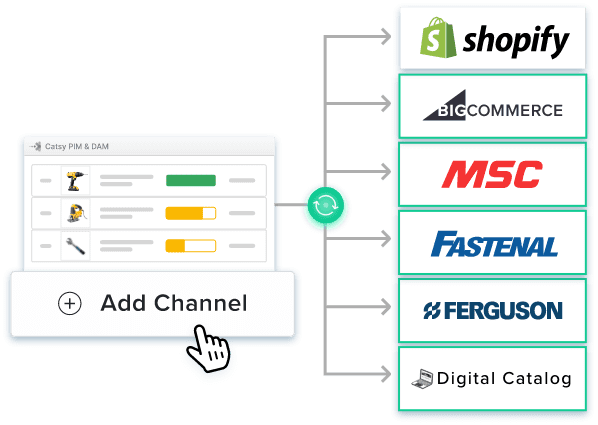The ROI of a PIM System & DAM: Calculate PIM ROI & Why Use Catalog Management Software?

- A catalog management strategy built on spreadsheets limits your growth.
- A catalog management strategy driven by a unified PIM and DAM system has measurable ROI.
- To secure executive buy-in, focus on quantifiable metrics to highlight the ROI of DAM and PIM and strategic value.
In this Article
Picture this: you are the lead, and your team is presenting a new catalog management software to the company. Across the table, the executive team watches with expressions ranging from mild interest to outright skepticism.
“This new catalog management solution,” you say, determination lacing your voice, “has the potential to revolutionize our product presentation. Not just streamlined processes, but tangible ROI.”
A ripple of raised eyebrows goes around the table. The CFO leans forward. “Currently, we have spreadsheets and shared drives – it works, doesn’t it? Why add another expense?”
You nod. “But ‘working’ isn’t the same as optimal. Imagine a scenario where no one mismanages product images, no customer comes across outdated descriptions, or that sales presentation falls apart at the last minute due to inaccurate data. This system – a catalog management software powered by a DAM and PIM – eliminates the inefficiencies and translates directly to faster sales cycles and less wasted time.”
Eyes flicker towards the projected figures on the screen. Now they are listening. You take a deep breath, ready to provide answers on the ROI of DAM and PIM solution.

An Overview of Catalog Management
What is catalog management?
Catalog management involves systematically listing the products you want to offer the market. This list is reorganized and updated regularly to reflect inventory and product lineup changes.
Typically, product catalogs contain details that customers may use to make purchase decisions. It differs from inventory management systems, which contain valuable information for internal teams. For instance, the details in an ERP system are only suitable for logistics and supply chain-related use cases. This information is bare bones and doesn’t care about the customer.
On the contrary, a catalog management system takes the foundational details and creates enriched product information. In other words, a catalog management system makes core product information customer-facing.
The system is analogous to the window of a physical shop. This window displays product information and entices passersby to enter the shop and sample the products. Like a meticulously arranged physical display, a well-managed catalog entices customers, provides clear information to make informed decisions, and ultimately drives sales.
Components of a well-managed product catalog
A well-managed product catalog is a harmonious blend of several vital components. These work together to create a seamless shopping experience for customers and streamline operations for businesses.
Firstly, it must contain accurate and comprehensive product information. This includes detailed product descriptions, technical specifications, high-quality images, and other relevant data. This information has two primary objectives: to help customers make informed purchasing decisions and enable search engines to index products correctly, thereby improving visibility.
Another critical element is consistent product categorization and tagging across the entire catalog. A logical, intuitive taxonomy helps customers navigate smoothly and find what they need quickly, improving the overall shopping experience.
Also, a well-managed product catalog should streamline data feeds for various sales channels. This element is crucial in today’s omnichannel world. The catalog must seamlessly integrate with various platforms, ensuring product information is consistently updated across all sales channels.
Lastly, the product catalog should be accessible offline. This is critical for industrial brands that engage customers through all available avenues, including offline channels like tradeshows. Of course, you can easily create a printable catalog in a platform like Adobe InDesign, but there is no guarantee that the information will be accurate and current. This happens when you rely on product details stored in spreadsheets, which may be scattered across local and cloud storage platforms.

Why Your Current Strategy Isn't Enough
Of all the key components of an effective product catalog, most catalog management systems easily provide the first and the second; they contain accurate and comprehensive product information and implement consistent product categorization and tagging across the entire catalog.
Let’s revisit the scenario where you lead a team presenting a new catalog management software to the higher-ups. One of the executives argues that there is no need for change because the current platform is working. Don’t change it if it isn’t broken, right? You and the team disagree with this position. So, you must convince the panel that the current strategy isn’t enough. The question is: how do you approach this presentation?
Suppose your organization uses Microsoft Excel to manage product information. This spreadsheet software is popular among businesses of all sizes for its versatility and robust data management capabilities. Not forgetting that it costs pennies and has been around for many decades. Therefore, one understands why decision-makers in an organization might be skeptical when employees suggest a shift away from MS Excel.
Limitations of a spreadsheet-based catalog management strategy
It helps to note that while Excel is a powerful tool, it may not be the best choice for all aspects of product catalog management. The problem is that these shortcomings could cost the company a small fortune in revenues and mitigation costs.
Some of the limitations that skeptical executives should be aware of include:
1. Error-prone data entry and manual updates
Spreadsheets are convenient. They have been around for ages; almost everyone knows how to use them. One can open a new sheet in Excel and start creating product information.
However, the limits of this platform quickly become apparent as your business grows. The number of products can produce too many details to fit in one sheet. This makes the spreadsheets cumbersome and error-prone with each new product line.
Also, users typically create product information in spreadsheets by manually typing the details. This opens the door to inaccuracies, duplications, and inconsistencies. For instance, simple human errors in formulas or copy-pasting can have rippling effects, leading to incorrect pricing, descriptions, or product availability being displayed to customers.
In other words, as catalogs scale, a spreadsheet-driven strategy becomes increasingly untenable. It saps productivity and jeopardizes brand reputation.
2. Difficulty maintaining data consistency across channels
A typical business today reaches customers via multiple avenues. You’ll find that a manufacturer has physical stores, sends sales representatives to trade shows, maintains an online store on its website, has merchant stores on various marketplaces, and maintains a digital product catalog. The goal is to reach as many buyers as possible, utilizing all possible touchpoints.
However, this strategy carries several risks, consistency being chief among them. With a spreadsheet-driven catalog management strategy, enforcing consistency is an uphill task. The fact that each channel has its own formatting requirements and data specifications makes matters worse. Spreadsheets are of little help in this regard because they lack the functionality to customize product information for each channel.
The biggest issue that makes spreadsheets and other similar tools for catalog management is that they do not have a centralized data storage and management system. Users cannot enforce uniformity, especially when the business has many products and variants. Without a centralized system to ensure uniformity, discrepancies can arise, confusing customers and eroding trust in the brand.
Additionally, there is no way to automate updating product information across multiple spreadsheets. This increases the likelihood of errors and inconsistencies, further exacerbating the problem. As a result, businesses may struggle to present a cohesive and professional image across all channels.
3. Lack of rich product information and visuals
Spreadsheets are primarily text-based platforms. This means they have limited capabilities for incorporating multimedia elements such as images, videos, and interactive content. As a result, product information may lack the visual appeal necessary to engage and persuade customers effectively.
This is unfortunate because research indicates that a catalog without visuals has slim chances of attracting shoppers. For example, one study concluded that the more visually attractive a product, the more shoppers choose it. Another study suggested that merchants who display user-generated product visuals attract more customers. These studies emphasize that the current business landscape consists of customers who rely heavily on images and videos to make purchasing decisions.
Although spreadsheets and other unoptimized catalog management solutions can store and organize product visuals, the functionality is too limited to generate a good ROI. Without the ability to display products in their best light, businesses risk losing out to competitors who offer more immersive and engaging product experiences.
4. Inefficient collaboration between teams
In a typical business setting, multiple teams, such as marketing, sales, and product management, often need to collaborate and contribute to the product catalog.
However, a spreadsheet-based catalog management strategy makes collaboration challenging. Spreadsheet tools like Excel and Google Sheets may support multiple editors but are designed primarily for individual use.
The characteristic that defines spreadsheets as designed for individual use – despite the many attempts to support simultaneous access by multiple users – is that they are often stored on local computers. Even when stored on a shared network drive or cloud drive, there is no capability to provide granular access. If one has edit rights to a file, they can make material changes without restrictions, even when they shouldn’t do that.
Additionally, spreadsheets do not support seamless coordination of updates and revisions. Communication barriers arise quickly, leading to misunderstandings or conflicting changes being made to the catalog.
Moreover, tracking changes and maintaining a clear audit trail becomes challenging without robust version control mechanisms. As a result, collaboration between teams may suffer, leading to delays in updating product information and addressing customer inquiries.
5. Limited scalability for growing product catalogs
With spreadsheets, you create more sheets to accommodate additional products and variants. The problem is that this approach increases the number of separate files you must deal with when managing product catalogs.
In other words, a spreadsheet-driven catalog management strategy becomes a bottleneck when your business expands. Some of the issues that arise include:
- Performance issues: Large spreadsheets get unwieldy, slow to load, and prone to crashing. This impacts productivity and frustrates teams.
- Data duplication: With multiple spreadsheets for different channels or divisions, product information often gets copied. This increases the risk of errors and makes maintenance overwhelming.
- Hard to manage relationships: Complex product relationships (kits, bundles, configurable options) are almost impossible to represent accurately within spreadsheet cells.
- Manual expansion: Adding new products requires manually adding rows and columns and adjusting formulas – a time-consuming task fraught with the potential for error.
It’s clear that spreadsheets (and similarly unoptimized platforms) were not designed for the scale and complexity of modern catalog management. If you said these words to the executives in the boardroom, they’d now want to know what alternative you are suggesting.
How do you justify a more robust catalog management software to upper management? Let’s guide you.

A Guide to Justifying Catalog Management Software to Upper Management
Hint: Start with the ROI of PIM and DAM!
Once you have exhausted the basics of why the company’s current strategy isn’t enough, it’s time to present the solution. This is the climax of the presentation, so it should answer the most critical question: does the new catalog management software offer a better ROI?
Note that you focused on the limitations while explaining why the current strategy isn’t enough. Since the current strategy is likely spreadsheet-driven, you pointed out how it is unreliable, error-prone, and imposes indirect costs that undermine the company’s bottom line.
The first step to justifying the new catalog management software is to explain it in detail. Let’s begin there.
A PIM and DAM platform is the perfect catalog management software
Product information management (PIM) and digital asset management (DAM) are crucial in product data management. PIM software deals with core product data, including descriptions, specifications, pricing, taxonomies, and relationships. This platform ingests product details from inventory management systems, allowing businesses to create a single source of truth for accurate, consistent, and up-to-date product information.
Unlike inventory management systems, PIM platform allows users to add metadata, tags, and other elements to create enriched information. Most robust PIM platforms provide templates to customize data for each channel before syndication. So, PIM software stores channel-ready product information.
Tightly integrated is digital asset management software focused on storing, organizing, and distributing all digital assets related to products – images, videos, documents, 3D models, and other rich media. DAM solutions allow teams to create, manage, and publish these assets while maintaining proper usage rights and brand standards.
Together, PIM and DAM provide an unparalleled product experience foundation. A product data management strategy built on the powerful duo enables businesses to manage, market, and sell their products across any channel or touchpoint without encountering consistency and accuracy issues.
Unfortunately, not everyone offers PIM and DAM as an integrated solution. Some vendors like Catsy have carved a niche offering a unified PIM and DAM. This is sold as a single platform, yet it has PIM and DAM functionality. So, while you usually perform product information-related activities in PIM and digital asset-related activities in DAM and then merge the content later, Catsy’s PIM and DAM solution allows you to map the content before syndicating it to channels.
Once the executives understand the basics of PIM and DAM, the next step is to explain why a unified PIM and DAM is a robust catalog management solution.

What is the ROI of PIM System and DAM System? Why use it for catalog management? An illustration
Suppose you’re preparing to launch a new line of eco-friendly products. This process will flow differently depending on what software powers your product catalog’s backend. Pay close attention, this is how you can justify the ROI of your PIM investment and DAM investment.
Method 1: Use spreadsheets to create and manage catalogs
Let’s assume that you choose to create the product catalog using spreadsheets as the source of information. A few things will be unavoidable. First, data quality will be inconsistent, as data will be scattered everywhere. You’ll likely have product specs in one spreadsheet, marketing copy in a shared document, and images in an unorganized folder on someone’s computer. This process lacks the efficiency needed for accurate product information management.
If a product name is mistyped, an image link is broken, or a discount percentage is incorrect, finding and fixing the errors will be frustrating and time-consuming.
Then, there is updating channels. Formatting data for your website, then separately for the store on Amazo, and then for a printed catalog is not only labor-intensive but also reduces efficiency, nmaking it prone to even more mistakes.
You will have a working product catalog at the end of this tedious process, but descriptions will be dry, and images will be low-quality. Overall, the product presentation will lack the quality product look that drives consumer trust and loyalty.
Method 2: Create and manage catalogs using a unified PIM and DAM
A unified PIM and DAM platform like Catsy’s centralizes product content. The PIM side stores all product details in a centralized repository, enhancing data quality and reducing manual errors. You can edit and enrich the data to make it more legible and appealing to customers.
The DAM side stores all relevant assets in a centralized hub, making it easy to leverage high-quality visuals and other media. It also allows you to add metadata and alt-text. You can then map the details to related assets within the same platform, significantly improving data quality.
The beauty of this platform is that you can create policies that define correctness and completeness, ensuring that any content failing to meet the requirements is flagged automatically. This PIM system helps maintain consistent, accurate product information across all channels. Once the information is ready for publishing, you can push it to different product detail pages (PDPs) in one click.
Using PIM enhances efficiency, reduces errors, and delivers reliable, trustworthy information to consumers.Some solutions provide more functionality. For example, Catsy allows users to generate PDF files of product information, effectively creating a print catalog.
Some solutions provide more functionality. For example, Catsy allows users to generate PDF files of product information, effectively creating a print catalog, which can help with market expansion and acquiring new customers.
CCatsy’s PIM and DAM also allow users to create a digital catalog embedded in websites. You can display your products on your website by integrating Catsy as the backend so that any changes made within the platform will instantly reflect on your website. This flexibility supports the right product information management software, offering long-term benefits and allowing for significant investment returns.
Besides seamless workflows and an enhanced shopping experience for consumers, a unified PIM and DAM platform is the perfect solution for catalog management because it is easy to calculate the ROI of PIM and DAM, delivering both quantitative and qualitative benefits.
How to evaluate and measure the ROI of a product information management+DAM-driven catalog management system
Return on investment (ROI) is the primary goal when presenting a new solution to executives. The C-suite needs tangible numbers to understand the ROI this new solution offers. Here’s how to evaluate the value of a PIM investment:
- Focus on increased sales and conversion rates: Use an ROI calculator to track website traffic and conversions before and after implementing a PIM system. Look for a rise in qualified leads generated through richer product content and improved navigation. A PIM system can offer insights into consumer behavior and patterns. Also, monitor shopping cart abandonment rates. A catalog management system built on a unified PIM and DAM system reduces these by providing clear, detailed information that eliminates purchase hesitation and helps to acquire new customers.
- Evaluate customer experience; has it improved? Conduct customer surveys and analyze reviews to measure satisfaction. Implementing a PIM delivers a smoother experience, leading to enhanced customer loyalty. Track customer service inquiries related to product information; if the inquiries drop, this indicates the PIM system reduces manual data handling and supports accurate product information delivery.
- Evaluate the costs associated with data errors: Some actions include calculating the cost of processing customer returns due to inaccurate product information. This calculation should be low because a PIM+DAM-driven catalog management solution drastically reduces these errors, saving you money. Secondly, estimate the cost of wasted time spent correcting errors and updating spreadsheets across departments. This should be lower when using the new solution because it streamlines workflows, freeing up valuable team resources. While at it, factor in potential lost sales due to outdated product information or poor product presentation.
Tracking and quantifying these metrics is critical because it helps to build a compelling ROI case for a PIM+DAM-powered catalog management software. Show the management team how increased sales, a happier customer base, and reduced operational costs directly translate to a significant return on their investment.
Conclusion
So, what’s the ROI of PIM & DAM? Time-to-market is critical for brands looking to capitalize on sales opportunities and outpace rivals, and any technology that accelerates product launches and multichannel execution deserves serious attention. A catalog management system powered by PIM and DAM System falls into this category.
A unified PIM and DAM platform creates a robust foundational backbone of product content. It unlocks measurable benefits of PIM and DAM that directly impact the business’s bottom line.
However, gaining C-suite buy-in often requires speaking their language – dollars and cents. As such, marketers must build a bulletproof business case that quantifies and weighs the solution’s ROI potential against the risks of sticking with outdated, inefficient processes. With hard metrics calculating projected revenue impacts, cost savings, and strategic growth opportunities, leaders will have a compelling incentive to embrace change in thinking about catalog management.
While spreadsheets seem like a convenient starting point, they quickly become limiting as your business grows. Spreadsheets are prone to errors due to manual entry and updates, making maintaining data accuracy and consistency across channels challenging. This leads to frustrated customers, wasted time on corrections, and missed growth opportunities. Additionally, spreadsheets cannot manage rich media content like high-quality images and videos, which are crucial for creating compelling product experiences in today’s online landscape.
A PIM and DAM system centralizes all your product information and digital assets. PIM ensures consistent and accurate product data across all sales channels, eliminating errors and confusion. DAM centralizes and streamlines the storage, management, and distribution of rich media content, ensuring consistency across all platforms. This translates into richer product experiences for customers, improved product discoverability, and, ultimately, increased sales.
Implementing a catalog management system powered by a PIM and DAM can lead to significant improvements in various areas:
- Increased sales: Richer product experiences with accurate descriptions, high-quality visuals, and enhanced product discoverability lead to higher conversion rates and increased average order value.
- Improved customer experience: Reduced customer returns due to accurate information, positive engagement with rich content, and overall satisfaction with the shopping experience.
- Reduced costs: Eliminating time wasted on manual data entry and error correction, streamlined workflows, and minimized costs associated with data-related issues like customer returns.
Focus on demonstrating the measurable ROI of the solution. Track key metrics like increased sales, improved customer satisfaction scores, and reduced costs associated with data errors. This data-driven approach will highlight how the new solution goes beyond the limitations of spreadsheets, paving the way for a future of efficient, data-rich catalog management that fuels sustainable growth and brand success.
A PIM+DAM-driven catalog management system accelerates time-to-market for new products by streamlining product data management, enabling faster content creation and enrichment, and facilitating seamless distribution across multiple sales channels. With centralized access to up-to-date product information and multimedia assets, teams can expedite product launches, respond quickly to market demands, and stay ahead of competitors.




